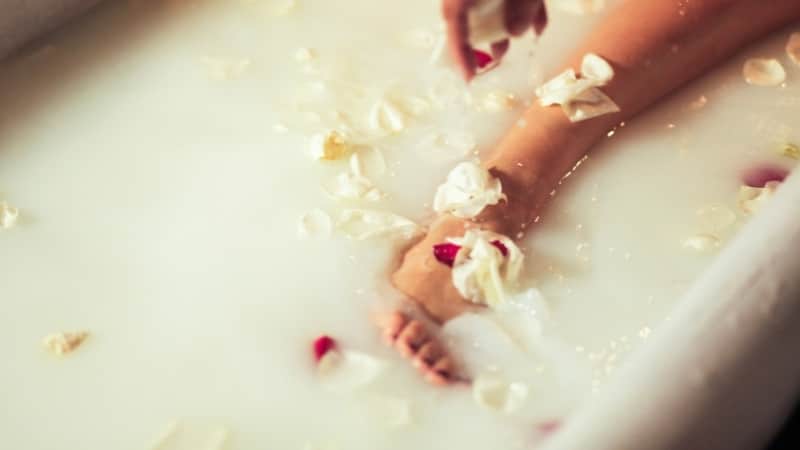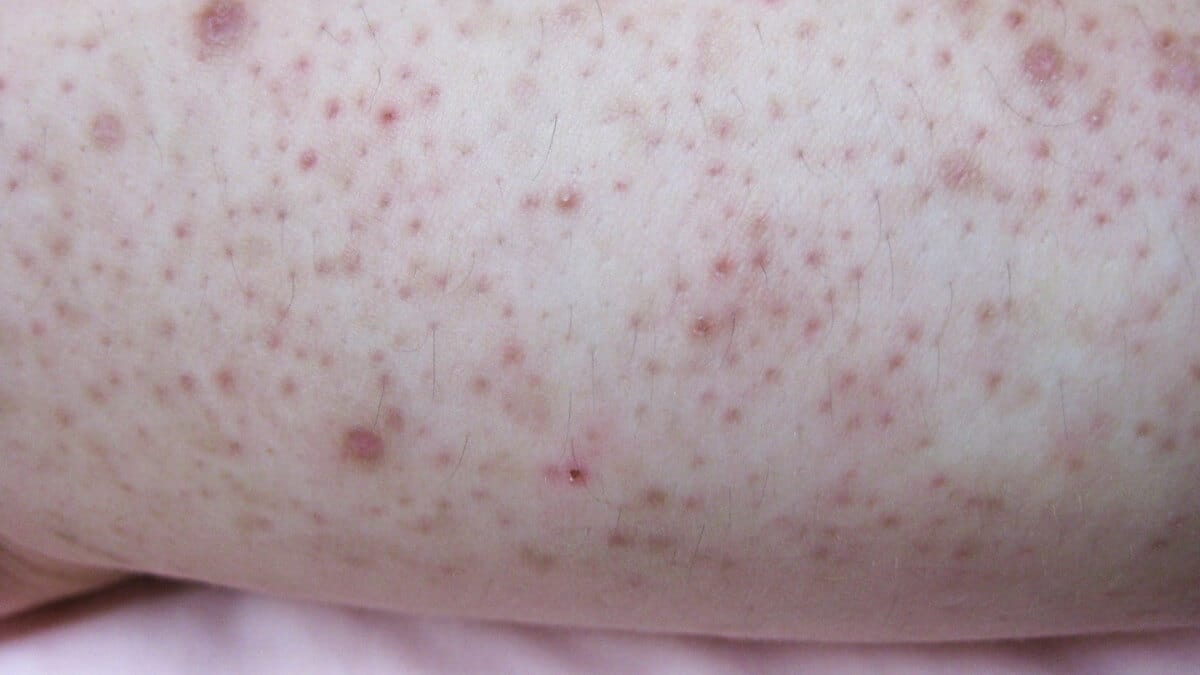Chicken skin is a cosmetic condition common in people that is harmless. It is usually observed in small tiny bumps on the areas consisting of thick skin.
Although this is the typical spread pattern, these bumps can practically occur anywhere on the body. Most people report this during the winter months. During the summer, the spots seem to heal up on their own.
What is Keratosis Pilaris (Chicken Skin)?
Keratosis pilaris, widely known as “chicken skin,” is a common medical condition characterized by rough, lumpy patches. Dead skin cells obstruct hair follicles, resulting in these little lumps known as pimples.
Have a look at Neem Skin Wellness; panacea for general skin inflammation.
They may be reddish or brown. Keratosis pilaris is a kind of keratosis that affects the cheeks, upper arms, thighs, and buttocks. In rare cases, one may have heard of chicken skin under the eyes.
It’s not contagious, and the pimples usually don’t cause any pain or irritation.
This problem is known to worsen during the winter months when the skin dries up, and it can also worsen during pregnancy.
In addition, people going through ichthyosis Vulgaris often face ketosis pilaris.
This harmless, inherited skin disorder has no cure. Still, there are several methods to manage it or prevent it from worsening.
Read: How to avoid face allergy?
What Causes Chicken Skin?
Keratosis pilaris is caused by a buildup of Keratin, a complex protein protecting the skin from toxins and infection. In addition, Keratin prevents hair follicles from opening, resulting in rough, lumpy skin.
It’s unknown why Keratin builds up in patients with keratosis pilaris. It might be caused by a genetic problem or a skin condition like atopic dermatitis. In addition, dry, rough skin aggravates keratosis pilaris.
NOTE: If you are taking the medicines like Momin Cream, Elocon 10 gm, etc for any such condition, do inform the doctor.
Also Read: Athlete’s Foot: A Fungal Skin Disease
How to Get Rid of Keratosis Pilaris?
Chicken Skin is mainly caused by winter dryness when the skin feels rough. As a result, the skin loses all of its moisture. This leads to the accumulation of keratin in hair follicles. Most Keratin gets washed away during summer.
Consider these tips if you have faced such conditions, which would undoubtedly help you treat this harmless yet annoying skin condition.
Best At-Home Chicken Skin Treatment
Treat yourself to a Milk Bath!

A moisturizing bath works great for chicken skin under the eyes or any other body part. Although it might seem like a dream too good to come true, taking a full milk bath is of great help in case you have chicken skin.
It is well known that milk is an excellent natural cleansing agent and the best cure for keratosis pilaris
Since the time of Mohenjo Daro, people have been using milk to clean wounds. This is because milk contains natural contents that usually aid in cleaning the skin. In addition, lactic acid is one of the main constituents of milk, which helps destroy these small tiny bumps.
To indulge in a milk bath, add an equal amount of water to the milk in a bathtub. First, make sure the water is warm. This is made sure that cold water dries up the skin, while hot water causes the skin to flare up. Next, soak your clothes inside the tub for ten minutes.
Apply Lemon Juice to the Affected Area.
Fresh lemon juice is very beneficial to the skin. The fluid can be used efficiently and directly onto the affected area of the skin. Make sure you rub the liquid on the bumps with the help of the pulp of the lemon.
The juice, along with the pulp, helps remove the accumulated Keratin. In addition, lemon juice is instrumental in de-clogging the filled pores. An added advantage to this procedure involves the disappearance of scars that are caused due to the bumps formed during this condition.
These are nasty scars and do not go away on their own. However, lemons have particular constituents that help disappear these scars.
Use a Yoghurt Pack
Yoghurt, like milk, contains many bioactive compounds that aid in the clearing up of skin. In addition, yoghurt is rich in bacteria and lactic acid.
Many people also use yoghurt to smoothen their skin after a rough weekend or a rough day. It is the most natural way of awarding yourself smooth skin.
Make sure you mix a pinch of salt into the yoghurt before applying it to the affected area.
Rub Your Skin With Olive Oil or Salicylic Acid
Olive oil is rich in Vitamin E. Vitamin E improves the skin’s health by improving the tone and texture of the skin. In addition, it can provide immediate relief from the chicken skin under the eyes or any other part of the body.
FAQs
1 Is it normal to have chicken skin?
Keratosis pilaris is a common, painless skin disorder that forms little, hard bumps that feel like sandpaper on the skin. You may have heard it referred to as “chicken skin.”
The bumps are usually pale in color. They commonly arise on the upper arms, thighs, and buttocks and are accompanied by redness and swelling. They can also appear on your face, although this is rare.
It affects many kids and adolescents, and it usually goes away as they become older.
2 How do you get rid of chicken skin?
There are home remedies and treatments available to get rid of chicken skin. The same has been mentioned above in the article.
3 How do you prevent chicken skin?
There is currently no one way alone to avoid keratosis pilaris; however, there are things you may do to reduce flare-ups, such as:
- Shower at a milder temperature and avoid hot baths; dry up the skin.
- To prevent over-drying or irritation of your skin, use moderate cleansers.
- Using a humidifier to keep skin moisturized throughout the dry months of the year
- Using moisturizers daily helps keep moisture in
- After a shower, pat your skin dry and avoid touching your skin aggressively.
4 Can foods cause keratosis pilaris?
Contrary to popular belief, keratosis pilaris is not caused by a poor diet. While several variables might contribute to developing this skin condition, one of the most common is your diet.
Some of the most common causes of keratosis pilaris are as follows:
- Ancestors’ genes
- It’s more frequent among youngsters and adolescents when it first appears.
- You’re not alone if you have asthma, obesity, or skin disorders like eczema or ichthyosis Vulgaris.
Keratosis pilaris is not caused by your diet. However, a diet rich in fruits, vegetables, lean proteins, healthy fats, and complex carbs can help to promote general health, including flawless skin.
5 Can waxing cause chicken skin?
Waxing might result in chicken skin. Exfoliate your underarms with scrub regularly to avoid this. To prevent underarm discomfort, don’t exfoliate after any hair removal procedure.
6 What does hyperkeratosis look like?
The symptoms of chicken skin feature rough and patchy skin that may feel different from the rest of the body. In a few cases, one may even notice swollen skin.
7 Does Sun Help keratosis pilaris?
An increase in humidity during winters is the stepping stone toward chicken skin. Sun will help quiet the keratosis pilaris. The rationale is a reduction in the moisture of the environment. Tanning and sunbaths are not recommended for the same.
8 Does coconut oil help with keratosis pilaris?
Coconut oil does wonder for treating KP. It is a fantastic moisturizer and does not contain any toxic ingredients. Coconut allergies are pretty uncommon; thus, there is a slim possibility that someone will be allergic to them.
The oil includes a safe and healthy acid that may break down layers of Keratin and dead skin cells in the same way as chemical-laden lotions do while still leaving your skin nourished and hydrated.
9 Does urea help keratosis pilaris?
Urea-based skin creams are particularly well-suited to everyday skincare. Urea inhibits keratinization by binding moisture to the skin. To get the most significant effects, use fragrance- and colorant-free lotions or creams and apply them to the afflicted region of the body many times a day.
I am sure that if you try these remedy techniques, you will surely get rid of these tiny bumps. If, however, you still face issues, go for medical advice, diagnosis, or treatment.
Tags: Treating Acne with 6 Natural Remedies, Three Types Of Skin Cancer, Knowing Some Common Allergic Diseases, Diseases You Are More Likely To Get While Traveling














